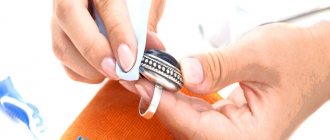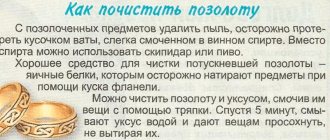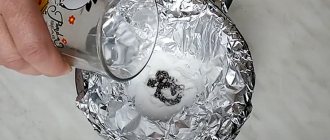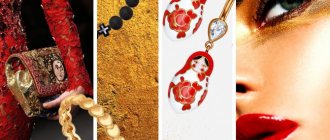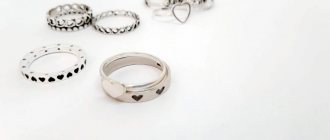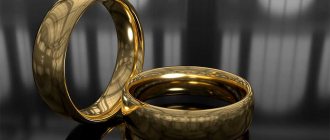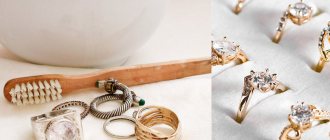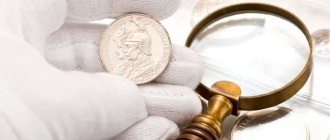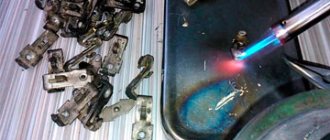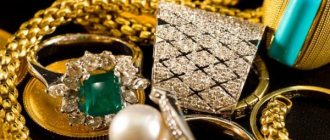Gold plated jewelry has always been popular. They look quite luxurious and elegant and at the same time are much cheaper than gold items. But, like any jewelry, gold-plated silver requires careful care.
If you notice that a dark coating has begun to appear on your favorite rings and chains, this is a sign that the jewelry needs to be cleaned. There are different methods for cleaning gold-plated silver, but not all of them are reliable or safe for your jewelry.
We are sharing with you proven ways to clean gold-plated silver at home quickly and safely.
Why does gold-plated silver darken?
Gilded silver is silver with a thin layer of gold on the surface. And over time, dark spots and a slightly greenish coating appear on silver jewelry with gilding (this is exactly the difference between gilded silver and pure silver).
We explained why pure silver turns black here. But how does blackness appear on a gold-plated product? Yes the same.
The reason may be either improper wearing (during cleaning or training), or careless care and storage. A dark coating on gold plating may appear due to interaction with household chemicals, cosmetics, certain medications, or due to contact with sweat or storage in a high humidity environment.
Therefore, if you want to keep silver and gold-plated items in their original form, do not forget to take care of them and clean them at least once every six months.
Why does the gold plating wear off?
The film that covers silver is thin, it can be damaged under unfavorable factors:
- Contact with water.
- Contact with aggressive substances.
- Improper care of the product.
- Friction on the surface of the human body.
Silver ring with gold plated
When worn every day, it is worth taking care of the jewelry so that it does not quickly lose its color and shine.
Excessive humidity promotes the oxidation of silver, since this metal is afraid of moisture. High-quality silver is inert, but the alloy is prepared not only from this component; copper and nickel are also used, which are used to dilute the silver. If the alloy contains too much copper or other metals, the jewelry will turn yellow, blacken and become coated.
Aggressive substances or reagents that accelerate the oxidation process are cleaning products, laundry products, and even some cosmetics. Therefore, before dressing for the evening, you should take off your jewelry and put it in a box.
The gilding layer can also wear off due to increased friction, so jewelry should be removed before playing sports.
Features when cleaning gold-plated silver
But you need to approach cleaning gold-plated silver wisely. Not all products are suitable, and some can damage thin gold plating.
Therefore, we immediately reject methods suitable for purifying silver or gold. And in order not to damage the gold plating, you need to prepare the product before cleaning.
- We take alcohol or turpentine and a soft cloth (you can use suede, wool or flannel. These materials carefully remove stains from the surface and add shine to things).
- We wet a cloth in the substance and carefully remove dirt and dust from the surface of the gold-plated silver.
- And only then can you proceed directly to cleaning the jewelry.
Removing gold plating
The easiest way to solve this problem is to take the product to a workshop. But you don’t always want to spend time on this, and then the question arises whether it can be done on your own. For this procedure, two methods can be used: mechanical and electrochemical. Before choosing the appropriate technology, familiarize yourself with all the pros and cons of this method.
Removing gold plating using a chemical method involves using aqua regia. The main objective of this method is to avoid damage to the base metal, that is, silver, while removing the top layer.
This is done as follows. First, all parts where silver is visible are coated with a protective coating. Next, the product is sent to a porcelain cup with aqua regia and heated. The gilding is slowly starting to come off. Once dark spots of silver chloride begin to appear, you need to remove the jewelry from the solution. Then you need to wash it with ammonia and remove the remaining gold plating with a brush.
Silver product before and after gilding
Removing gold plating using the electrochemical method involves using an electrolytic bath and a copper plate. The electrolyte, which in this case serves as the anode, is a 7% solution of potassium cyanide in distilled water. The copper plate is used as the cathode. After treatment, the product is removed from the bath and washed with a stream of water. Remains of gilding are also removed with a brush.
In both the first and second methods, not all of the coating is removed. Removing gold plating at home is completely possible if you purchase: a power supply with adjustable voltage and polarity, battery electrolyte, distilled water and thiourea. Prepare an electrolyte and a glass jar, where you place the anode with decoration and a steel cathode. Apply 3.5 volts to them. Do not open the can during the reaction as hydrogen sulfide will be released.
Cleaning products
Before you clean gold-plated silver items, you need to choose the cleaning product itself. For such things, only soft, gold-plating compatible compounds are suitable, which will not damage or scratch the thin surface layer of gold. Therefore, we immediately remove any abrasive products away.
To clean gold-plated silver, you can use both professional cleaning products and time-tested folk recipes.
Toothpaste
It seems that toothpaste is used to clean everything, and gold-plated silver is no exception. To clean a small stain, lightly wet the item and apply toothpaste over the entire surface and wipe with a lint-free cloth. With this method, it is not recommended to use even a soft toothbrush, as it can leave micro-scratches on the gold plating. Suede or flannel fabric will be an excellent alternative to a brush.
Yolk
Chicken yolk will help restore your jewelry to its former shine and shine. To do this, beat the yolk thoroughly and start peeling. Use a soft sponge or lint-free cloth. And to enhance the effect, you can mix the yolk with javel water (a solution of hypochlorite and sodium chloride).
Egg white
Or you can use white instead of yolk. Beat the egg white and add ½ tbsp. spoons of whiteness, apply the product to a cotton pad or cloth and wipe your favorite rings and earrings. Rinse off any remaining protein and wipe dry. Done - your jewelry shines as it did on the first day of purchase.
Special means
But in addition to folk recipes, there are professional products that are created specifically for cleaning gold-plated silver. They can be bought at almost any jewelry store, although the cost can be quite high. The Aladdin solution for cleaning silver has proven itself well. In general, when choosing a product, carefully read the instructions; it should indicate whether it is suitable for gold-plated products, or consult a specialist.
Sugar
Well, let's get back to folk recipes. You won’t believe it, but with the help of sugar you can not only clean difficult stains from objects, but also restore shine. This is also one of the safest and most effective ways to clean gold-plated items.
- First, degrease the gold-plated item with alcohol.
- Then take 2 tablespoons of sugar and stir in a glass of warm water.
- Place the decoration there and leave for several hours (from 3 to 10).
- Afterwards, rinse with running water and dry with a paper towel.
Beer
It's better to take a good dark beer. Pour into a glass, place a gold-plated object there, and leave for 30-40 minutes. Remove, rinse and dry. Ready. But remember, beer can only correct shallow surface stains.
Baking soda
Baking soda is a universal cleaner. For gold-plated silver, it can also be useful if you follow our recommendations.
- Dilute the soda solution: 2 tbsp. l of soda per 1 l of hot water.
- Place the product in it and leave for 30 minutes (in difficult places you can use a soft cloth or cotton pad).
- Rinse with plain water and dry the jewelry.
And now what NOT to do:
- Rub gold-plated objects with dry soda.
- Clean jewelry with stones or ornate designs.
Dry soda can damage the coating or remain as a white coating in hard-to-reach areas of the product.
Ammonia
Ammonia is a good way to clean heavy stains and get rid of green deposits. To do this, apply a soap solution and add 7-10 drops of ammonia to it. Leave the gold-plated items in the resulting liquid for 1-2 hours.
If you want to speed up the process a little, then mix warm water and ammonia in a 1:1 ratio in a glass and leave the products for 15-20 minutes.
When cleaning with an ammonia solution, you need to strictly maintain the soaking time of the jewelry. If you wait too long, the gilding may come off.
Vinegar
Wine vinegar will help you get rid of blackness quickly and without damaging the gold surface. Simply soak a cotton pad or cloth in wine vinegar and wipe down your earrings or cutlery.
Table vinegar
You can also wipe jewelry with table vinegar, just like wine vinegar. Or you can soak them in it.
In the first case, add 2 tbsp. l vinegar (take 9% table vinegar) in a glass of warm water. Take a cotton pad or sponge, soak it in the resulting solution and begin cleaning.
In the second option, we also take 2 tbsp. l of acetic acid and add to 1 liter of water, mix and place in a container with the product, leave for 15 minutes. Afterwards, rinse well and dry. If you don’t wash the vinegar off the surface well, it will gradually begin to destroy the top layer of gold, so we wash it very well.
Soap solution
Ordinary water and soap can clean gilding from dust and old dirt and restore its shine. Add a teaspoon of liquid soap to warm water (hard soap can be grated and the resulting shavings mixed in water). Then simply soak the items in this water for 20-30 minutes. Then rinse under the tap and wipe dry.
Hydrogen peroxide
Hydrogen peroxide effectively cleans both gold and silver, as well as gold-plated items. But not alone. For quick and high-quality results, add 1 tbsp to the soap solution. l ammonia and 2 tbsp hydrogen peroxide. Leave the gold-plated silver in this solution for 20-30 minutes. Next - everything is as always: rinse, wipe, polish.
Alcohol and turpentine
These two substances are used both for the preliminary cleaning of gold-plated silver and for the prevention and removal of light plaque and darkening. Simply soak a soft cloth in a solution of alcohol or turpentine and wipe (without pressure) the jewelry.
How to maintain color and shine?
Simple tips will help preserve the color and shine of jewelry; it is recommended to remove jewelry before:
- taking a bath or shower;
- sports training;
- cleaning, washing.
Jewelry should be protected from moisture, so remove it before going to the bathroom or shower. Soap solution can negatively affect the condition of the gilding and damage the coating.
Gold plating is susceptible to friction; over the years, the coating may become thinner, so you should not wear items made of gold-plated silver during active sports.
Aggressive reagents act on the coating, damaging it. As a result, dark spots appear on the jewelry, which will be difficult to get rid of.
Proper care will help preserve the color and shine of the product; for this you will need:
- Suede leather.
- Ethanol.
- Vinegar.
Suede is used to polish jewelry; this can be done immediately after cleaning or instead of it.
In any case, the silver layer cannot be damaged, but the gold plating may wear out when in contact with aggressive agents, so jewelry should not be immersed in solutions with soap, salt and soda.
Candy bowl made of silver with gilding of individual parts
You can wipe the product with alcohol, first apply it to a cotton pad or lint-free cloth.
Dip jewelry into a solution of vinegar and water for no more than 20 minutes if the contamination is severe. If routine cleaning is required, you can simply wipe the metal surface with a cloth soaked in a vinegar solution.
Alcohol adds shine, but the products can also be placed in beer, for which one glass of this drink is enough. Decorations are immersed in beer for 15–20 minutes, no more.
How to wear and store correctly
To ensure that your favorite gold-plated jewelry does not lose its original brightness and shine, treat it with care and store it properly.
- Remove rings when washing your hands and when applying cosmetics to your skin.
- Do not wear gold-plated items to fitness classes or in the shower or sauna.
- Wipe with a soft cloth after each wear.
- Store jewelry in a box, away from sunlight.
- Follow these simple rules and your jewelry will delight you for a long time.
Is gold-plated silver washable or not and how to care for it
An excellent way to pamper yourself with jewelry with your favorite gold glitter at an affordable price is to purchase gold-plated silver. At the same time, it is very difficult to visually distinguish a gold-plated product from a gold one. But many customers are interested in: is gold-plated silver erased or not, is the gold-plated film damaged during wear? Without going into too much detail about the application, you need to remember that gold plating is simply a very thin top layer on silver jewelry. Like any coating, it will wear off sooner or later, of course.
How quickly the gilding on silver wears off depends on how carefully you wear the jewelry.
The average lifespan of gold plating is two years of constant wear.
To delay this moment, you need to treat gold-plated jewelry very carefully, care must be very thorough, otherwise the gilding will quickly wear off, and the silver in shabby areas will become covered with a dark patina.
Spray erasing occurs for a number of reasons:
- Long-term wearing. Friction against the body, friction against clothing, against all kinds of surfaces (such as a table, fork, bag, etc.) - The use of aggressive substances and reagents that accelerate the oxidation process - these are cleaning products, laundry products and cosmetics. Therefore, before dressing for the evening, you should take off your jewelry and put it in a box. A ring worn on hands smeared with cream is doomed to oxidize. When removing nail polish, drops of acetone lead to the same result. The same will happen when spirits enter...
— Storage near heating devices and in places exposed to direct sunlight. You cannot store gold-plated silver in boxes made of cardboard, as the packaging can release, for example, sulfur, which adversely affects gold-plated jewelry.
— Gold-plated jewelry is “afraid” of high humidity. Therefore, the bathroom is the worst place to store jewelry. You should not wear such jewelry in the rain, and wash your hands while wearing rings.
- Taking medications. Some medications contain substances that can adversely affect the appearance of gold-plated silver jewelry. — Mechanical damage: impacts, scratches, — Incorrect (rough) cleaning of products.. — Leather characteristics. Fatty discharge The last reason is the most common. The more often an alloyed precious metal is exposed to sweat, the faster it oxidizes. Therefore, the same product serves one owner for a long time and quickly becomes dark for another.
Why does a silver item plated with rose gold turn green?
Any shades are a sign of an oxidizing ligature. The greenish color comes from copper oxide. That is why, when oxidizing, red gold with a high content of copper alloy turns green more often than others. (Ligature is an alloy that changes the color of the precious metal)
on a silver ring will be erased faster . But the gilding on earrings will last much longer.
Chains and bracelets will also quickly lose their gilding, since when worn they rub off on the skin and clothes. Plus, the chain links rub against each other, which also wears off the gold plating very quickly.
Sooner or later, any owner of gold-plated silver jewelry is faced with tarnishing. This often looks like heavy contamination.
How to maintain color and shine? It is recommended to remove jewelry before:
- going to the bathroom, bathhouse or shower to protect from moisture and soapy water, which can negatively affect the condition of the gilding and damage the coating:
— sports training;
- cleaning, laundry
Gold-plated items should be stored in a box.
Proper care will help preserve the color and shine of the product; for this you will need:
Suede leather. Ethanol. Vinegar. To effectively remove stains caused by grease and dust, simply wipe the product with alcohol, previously applied to a cotton pad, sponge or lint-free cloth.
To cleanse stronger stains, you can use vinegar essence, after diluting it with water. A 9% composition is suitable for cleaning. It is recommended to pour 30 ml of table vinegar into 1 liter of water, keep the jewelry in this solution for ¼ hour and rinse it with tap water.
If routine cleaning is required, you can simply wipe the metal surface with a cloth soaked in a vinegar solution.
To restore shine to faded items, you can place them in beer, for which one glass of this drink is enough. Decorations are immersed in beer for 15–20 minutes, no more. After this, it is washed with tap water and cleaned with a suede cloth.
If the jewelry is so dirty that it has already turned green, then it can be cleaned with a solution of soapy water and ammonia. To prepare the composition, you need to pour 5-10 ml of dishwashing detergent into 1 liter of heated water and add 5-6 drops of ammonia solution. Gilded objects are kept in the product for half an hour. After washing under running water, the products are dried and rubbed with suede.
Suede is used to polish jewelry; this can be done immediately after cleaning or instead of it.
Of course, the best way to clean gold-plated items is to have them professionally cleaned by a jewelry workshop. Don’t be too lazy to give your ring or earrings to an experienced craftsman once a year.
Even gold loses its luster and color over the years, and it is even easier to damage the gilded film. If you take proper care of your jewelry, it will last a long time and the coating will not wear off quickly.
